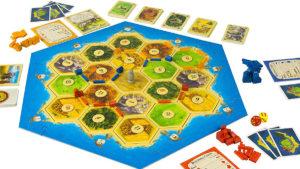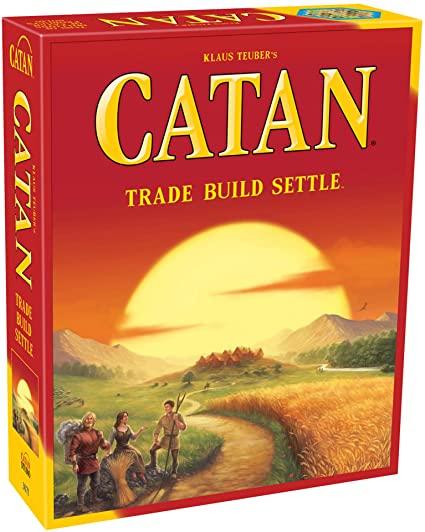For this critical play, I chose to analyze Settlers of Catan, which is my absolute favorite board game and playable online at colonist.io. The original board game was designed by Klaus Teuber and is manufactured and sold by CATAN GMBH. I started playing Catan because it was gifted to me by my uncle around age 12, and I think the game is appropriate for ages around ten and older; there is nothing inherently inappropriate or mature about the game, and playing only requires basic understanding of resource management and strategy.
The game begins with a random (and/or player-built) board consisting of hexagonal tiles:

Each tile represents a specific resource that players “mine” by rolling the number on the tile. Numbers are not attached to the tiles and can be moved around to change gameplay. Winning Catan requires earning 10 victory points, which usually come from building settlements (each player begins with a house and two roads, which they place adjacent to three tiles, and they can only “mine” from tiles they have built on), from achievements (such as building the longest road), or from drawing Development Cards. All three of these strategies “cost” resources: players exchange game-prescribed combinations of resource cards for cards or construction materials.
As a result, Catan gifts players with several different types of fun: Fantasy (by existing on the hypothetical island of Catan), Challenge, and Fellowship (when players trade with each other or collaborate to stop someone with a lead).
I always enjoy playing Catan! It’s one of those games that you can spend hours on, especially if you use the 10-point to decide who wins. There’s a lot of unexpected strategy required when placing settlements on the board, trading with other players (especially when you don’t know what resources they have), and deciding when to draw Development Cards. You can also develop specific types of gameplay: some players will “monopolize” a certain resources or frequently draw cards.
On the flip side, Catan can be immediately unfair to players who lack experience and don’t effectively place their starting settlements. There are also moments towards the end of the game where players are just exchanging the “Longest Road” achievement or waiting on specific dice rolls to build the settlement that would close out the game. I think that combining tiles with the dice numbers that represent the mathematical importance of each resource could make Catan more playable.
As covered earlier, I think that Catan can be intentionally set up for balance to prevent “asymmetric” gameplay. There is, of course, an inherent advantage when playing Catan for the tenth time against a first-time player, but I think, again, that the board can be set up to give the first-time player an easier time. And, of course, the randomness of dice rolls prevents any game from being predictable. Balance between strategies is a necessary component of Catan; it is almost impossible to gain all 10 victory points without both building settlements and drawing cards. Furthermore, your resources often dictate what strategy you use at each point in the game.
The game-prescribed combinations of resources prevents any resource from having overwhelming purchasing power over the others. I believe that this is a transitive relationship between resource cards, but I can also see purchasing as an intransitive relationship, as one resource is useless with others. There are no “fruity” cards, except perhaps the awards for “Longest Road” and “Largest Army.”



